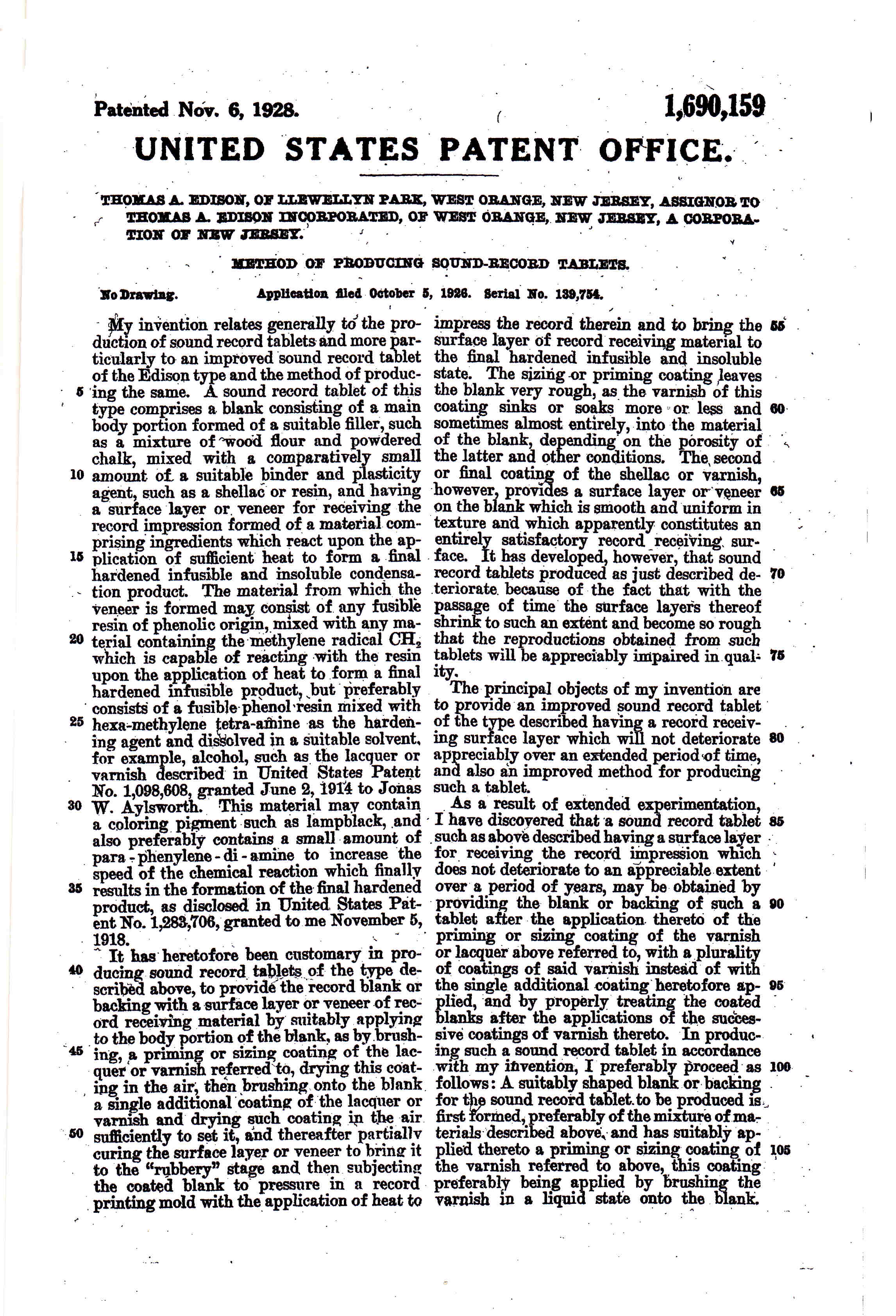EDISON DIAMOND DISC CONCERTS


CONTACT : COMMENTS AND QUESTIONS
back/home
I grew up in a country town, Bowen , in North Queensland in the Thirties.
Our nearest broadcast transmitter, 4QN, had a power output of 6.6KW and was situated at
a distance of about 100 miles.
Static frequently rendered the signal unuseable on summer nights, and entertainment came
from recorded music, usually an Edison Diamond Disc - Sheraton Model - although there was also
a gramophone which played laterally recorded 78 discs in the house.
The discs were chosen at random and the concerts usually lasted about an hour.
The following concerts are chosen to "re-create" - as Edison would put it - those times.
Each concert lasts about 80 minutes and is a mixture of acoustic and electrically recorded discs.
The discs came from the collections of Mr. Peter Tadman and Mr. John Simpson.
Many thanks to them for their foresight in collecting and preserving these wonderful discs
demonstrating the verve and drive of the Edison orchestras, and preserving the memory of almost
forgotten melodies.
The discs will probably come as a shock to those used to modern "pop" recordings.
They contain novelties like melody, rhythm, and understandable words : all performed by
professional musicians.
The discs "re-create" exactly what went on in the recording studio with no editing : no Auto-Tune!
The statement that lateral recording is ""superior" to vertical recording seems to be almost universal.
This belief seems to have originated from an analysis of tracing distortion by the Cruft laboratory,
Harvard in 1941:-
A Theory of Tracing Distortion in Sound Reproduction from Phonograph Records
by W.D. Lewis and F.V. Hunt
The Journal of The Acoustical Society of America pp 348 - 365 1941
The mathematics predicted the absence of even order harmonics in lateral recording while vertical recording
produced both even and odd harmonics.
This is not surprising.
The shape of the reproduced waveform when a spherical stylus travels over
a "hill" is different from when it traverses the bottom of a "dale".
The tracing distortion from a vertical cut disc shows asymmetry.
On the other hand, left and right deviations in a lateral track produce the
same distortion. The tracing distortion in lateral recording is therefore symmetrical.
Now asymmetry produces even order distortion and symmetry produces odd order
distortion.
It is not surprising, then, that second order harmonic distortion in vertical recording
came out of the above analysis. The first distortion component in lateral recording
was third harmonic. This seemed to give vertical recording a bad name and interest was lost.
This is a pity.
The analysis does not tell the full story.
Vertical recording has a lot of desirable characteristics such as: longer playing time:
freedom from retracking on overcutting: no problems with stylus fit - its greatest strength.
Vertical recording gives rise to excellent geometry in acoustical recorders and reproducers.
Here the recording or reproducer diaphragm is parallel to the record surface with a very direct
linkage to the stylus.
In lateral recording the diaphragm is at right angles to the record surface and a complicated lever system
is used to communicate lateral diaplacement to the cutting stylus.
This can only degrade the transient or high frequency response.
It is highly significant that Bell engineers chose vertical recording for their high fidelity experiments
in the early thirties.
Tracing distortion decreases with the diameter of the reproducing stylus. The limit on this is set by
the pressure on the disc surface set by the dynamic forces in the reproducer.
With modern light weight pickups the diameter of the reproducing stylus in vertical recording
can be greatly reduced with a dramatic reduction of ALL tracing distortion.
For Edison Diamond discs I use a 1 thou. spherical stylus at a weight of 1.5 grams.
Unlike all my lateral 78s, no tracing distortion is evident on the
end of the Edison tracks.
Edison always believed in the superiority of vertical or " hill and dale " recording.
I think his intuition got it right.
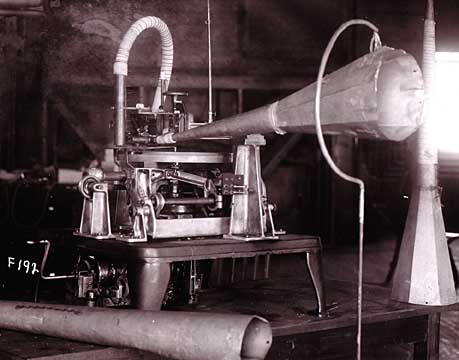
|
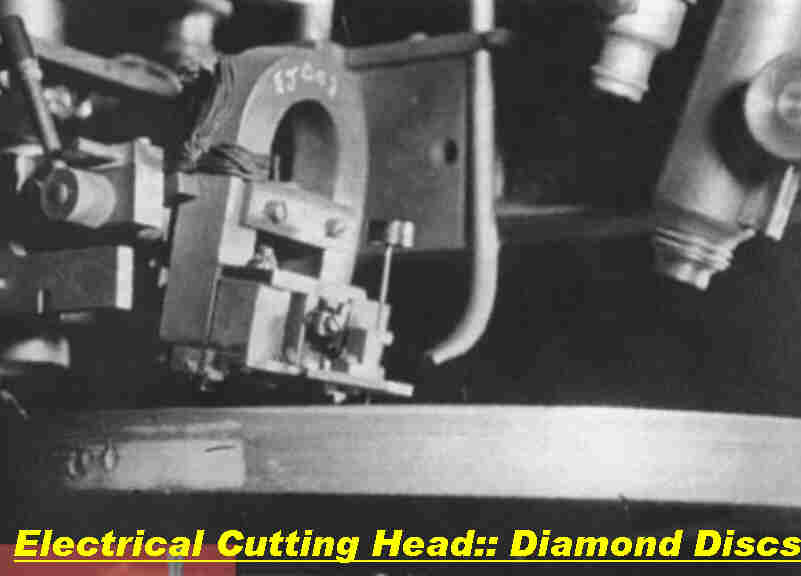
|
|
AN EDISON ACOUSTIC RECORDER |
AN EDISON ELECTRICAL RECORDER |
A stereo pickup can be made to respond to lateral or vertical recording by adding or subtracting
the left and right channels.
The gain of these two channels direct from the pickup is seldom matched, so a better solution is to provide preamps
whose relative gains can be changed over at least +(-) 20 % .
To play a vertically cut disc the preamplifier outputs are at first added to respond to the lateral component.
The relative gains are then set for minimum output.
The outputs are then subtracted to play vertically cut discs.
The Diamond Discs were recorded at 80 RPM not 78. This was to facilitate the gearing in slow speed pantograph transfer
from disc to cylinder.
The cylinders were recorded at either 120 or 240 RPM.
The discs were recorded at 0 degrees tracking angle, but modern pickups have a vertical tracking angle 15 to 20 degrees
from vertical. The thickness of the dicsc on the turntable reduces this tracking angle.
Varying the tracking angle produced no discernable distortion : probably because the maximum peak signal on
the disc is only 0.8 thou., so no attempt was made for further correction.
SEE PREAMPLIFIER and DISC EQUALISER
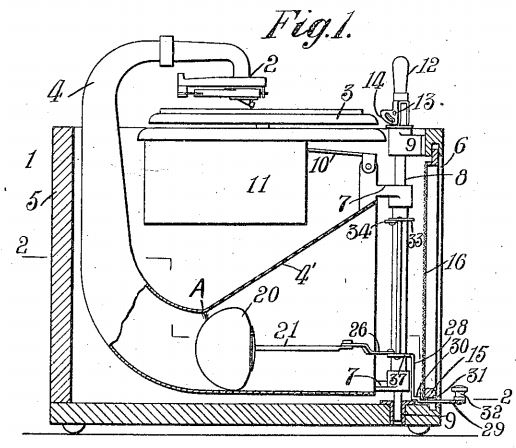

 Edison knew about distortion caused by errors in the tracking angle in his 1888 patent.
Edison knew about distortion caused by errors in the tracking angle in his 1888 patent.
The diamond disc acoustic reproducers all exhibit quite large tracking errors for a disc recorded with a vertically
cut track.
This is illustrated in the drawings opposite.
SEE :: CUTTING HEAD DESIGN : EARLY ATTEMPTS
The low peak displacement ( about 0.8 thou. ) on an Edison acoustic disc probably reduces the tracking angle distortion to a tolerable level.
It was shown in the "EDISON" section on this site that the dominance of viscous damping in the
acoustic cutting heads produced a constant velocity recording characteristic.
If p(t) is the pressure at the mouth of the recording horn then the displacement depth on the disc y(t)
is given by:-
y(t) = K1 ∫ p(t) dt
For a magnetic pickup the voltage output Vo is given by:-
Vo = K2 dy(t)/dt
So the raw output from a magnetic pickup is given by:-
Vo = K2 dy/dt
Vo = K2 d /dt [ K1 ∫ p(t) dt ]
So Vo = K2 K1 p(t)
There should be direct path through the preamp for Edison acoustics.
ELECTRICALLY RECORDED EDISON DIAMOND DISCS
From listening tests it appears that Edison electricals adopted the recording curve used in lateral recordings at the time:-
Below 250 Hz - constant amplitude
Above 250Hz - constant velocity
The only groove shape appropriate to vertical ( hill and dale ) recording is
the segment of a circle.
Edison realised this very early in the development of recording and patented
the groove shape on 17 June 1890 Pat: 430278.
In vertical recording with full modulation, the bottom of the groove can reach
the surface.
To maintain contact, the reproducing stylus must sit on the bottom of the groove.
A spherical reproducing stylus with a diameter smaller than the cutting stylus
is a necessary but not sufficient condition to track a fully modulated groove.
Note that the problem of "groove fit" does not exist in Edison vertical recording.
The diameter of the spherical reproducing stylus can be reduced until the surface pressure
induced by the large forces encountered in acoustic reproducers starts to cause unacceptable
disc wear.
The text and diagram from patent 430278 are shown below.

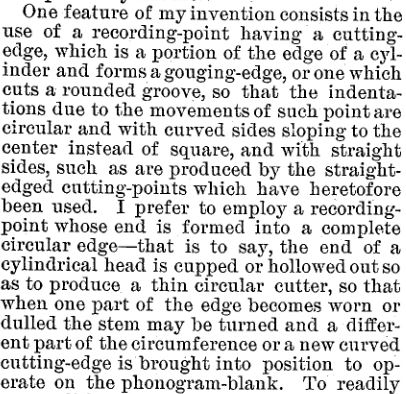
Drawings from other Edison patents indicating a circular grove shape
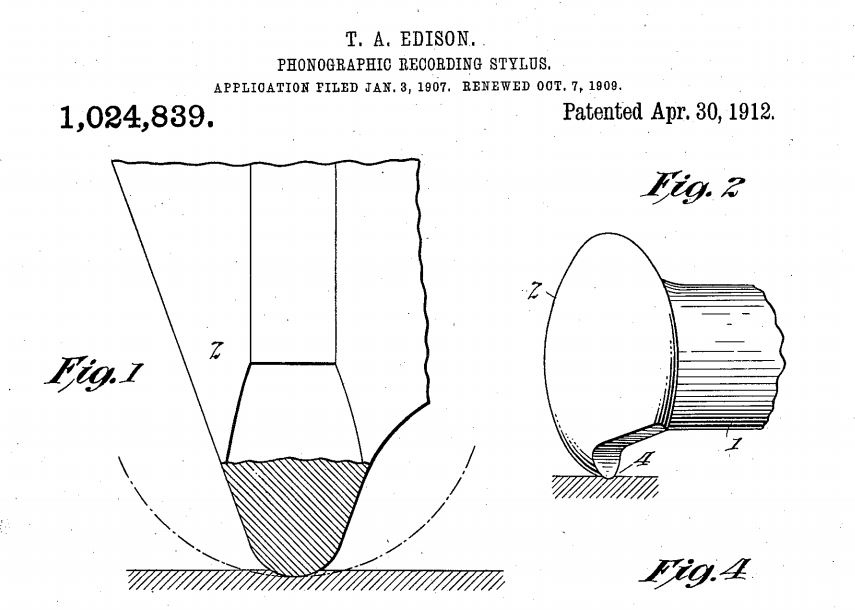

We now have to determine the maximum diameter of the conical stylus which will trace a groove recorded
with maximum signal velocity by an Edison acoustic recorder.
Although the stylus may trace the groove, it wlll still produce tracing distortion. The stylus diameter must be much
smaller than the maximum to reduce tracing distortion.
Edison Diamond Disc acoustic recorders approximated the ideal constant velocity recording characteristic
with the use of heavy viscous damping.
For a constant velocity track we can write:-
A = Dm [ fo/f ]
where :-
A = peak amplitude of sinusoidal track cut at a frequency f
Dm is the peak deviation cut into the track at the lowest recorded frequency fo
Note the lowest recorded frequency appears to be about 150 Hz. , but the response is well down at this frequency
due to horn miss- matching. (See computer results below)
We can estimate that the maximum response occurs about 400 Hz. so:-
fo = 400 Hz. :
Dm = 0.8thou.
The sensitivity of the recorder is set in the studio to get this result - maximum loudness without overcutting.
MAXIMUM RECORDED VELOCITY V
For a sinusoidal track we can write for the deviation y :-
y = A sin( 2 Π f t )
V = dy/dt = 2 Π f A cos( 2 Π f t )
Vmax = 2 Π f A
But A = Dm [ fo/f ] from above
Vmax = 2 Π f Dm [ fo/f ]
Vmax = 2 Π fo Dm
From above: fo = 400Hz. : Dm = 0.8 thou.
So Vmax = 2.01 in/sec.
Vmax = 5.11 cm/sec.
This is much lower than the peak velocity encountered on a modern microgrove recording.
The peak signal force Fp at the stylus tip is given by:-
Fp = Vmax x |Z|
where Z is the mechanical input impedance at the stylus tip.
In vertical recording if Fp is lower than the weight of the pickup, then the stylus will track.
Since Vmax is small, Fp is small and very light weight pickups can be used.
I usually use 1.5 grams.
The low peak velocity helps to explain why vertical tracking errors seem to produce little distortion.
RADIUS OF CURVATURE - R - OF AN ACOUSTIC TRACK
The radius of curvature R is given by:-
R = [ 1 + ( dy/dx )2 ]3/2 / [ d2y/dx2 ] -------(1)
For a sinusoidal track:-
If A = peak deviation and λ is the wavelength along the track and b = 2 Π / λ then
y = A cos( b x ) represents a vertical track cut on the disc.
dy/dx = - A b sin( b x )
d2y/dx2 = - A b2 cos( b x )
Substituting these in (1) we get:-
|R| = [ 1 + b2 A2 sin2(b x ) ]3/2 / [ b2 A cos( b x ) ]
This has a minimum at x = 0 at the peak of the wave so :-
So Rmin = 1/b2 A ------ (2)
But b = 2 Π / λ
So Rmin = λ2 / 4 Π2 A -------(3)
Here λ = v/f
Here v is the track velocity and f is the recorded frequency
From above for a constsnt velocity recording
A = Dm fo / f
Substituting in (3) we get:-
R = [ 1/4 Π2 Dm fo ][ v2 / f ] --------(4)
Note that the radius of curvature is inversely proportional to frequency with constant velocity acoustic recording,
so the minimum radius of curvature on the track will occur at the highest recorded frequency here taken as 4KHz.
We can now calculate the mininum radius of curvature on the inside of a disc:
Assumrd minimum inner radius r = 5 cm = 1.9685 inches :
RPM = 80 per minute
Then v = 2 Π r RPM / 60 in/sec
v = 16.49 in/sec
Dm 0.8 x 10-3 inches
fo = 400 Hz.
Substituting in (4) we get :
Rmin = 5.38 x 10-3inches
Note that the wavelength on the disc = 4.12x 10-3 inches
A conical stylus with a diameter of about 11 thou. will just fit into the trough of an acoustically recorded Edison
disc, but would produce horrendous tracing distortion. To reduce this distortion to a negligible value the diameter
should be reduced by a factor of 10 : say to 1 thou.
This will also reproduce high frequency noise on the disc which can be eliminated by low pass filtering -
for instance fourth order maximally flat with a cutoff frequency of 6.5KHz seems about right.
This works well for discs in good condition.
For discs with wear and dirt an increase in stylus diameter may lessen the noise and distortion :
freedom from tracing distortion is no longer the overriding consideration.
In vertical recording, peaks in the waveform appear as spikes on the track and can be flattened by the
large forces produced by an acoustic reproducer. A larger diameter stylus tends to ride over these
and specks of dirt on the bottom of the track.
This is a non -linear process and not equivalent to extra lowpass filtering with a 1 thou diameter stylus.
For general work, such as transferring a large number of discs to a CD for home use, a 1thou diameter stylus and
low pass filtering seems appropriate.
If more time is available to transfer a worn and dirty disc for archieval preservation, then trials using a
progression of conical stylii with diameters from 1 to 4 thou. seem appropriate.
Some physical insight into the radius of curvature can be gained by rearranging equation (3)
Rmin = [ 1 / 4 Π2 ][ λ ][ λ/A ]-------(3)
The useable stylus size for small wavelengths λ can be increased by increasing the ratio
λ/A : that is by reducing the amplitude of the cut A.
An acoustic reproducer has a very high mechanical input impedance to give high forces at the stylus tip.
Edison used a reproducing stylus with a diameter of 7 thou to reduce the surface pressure on the disc.
The diameter of the recording stylus was 10.5 thou.
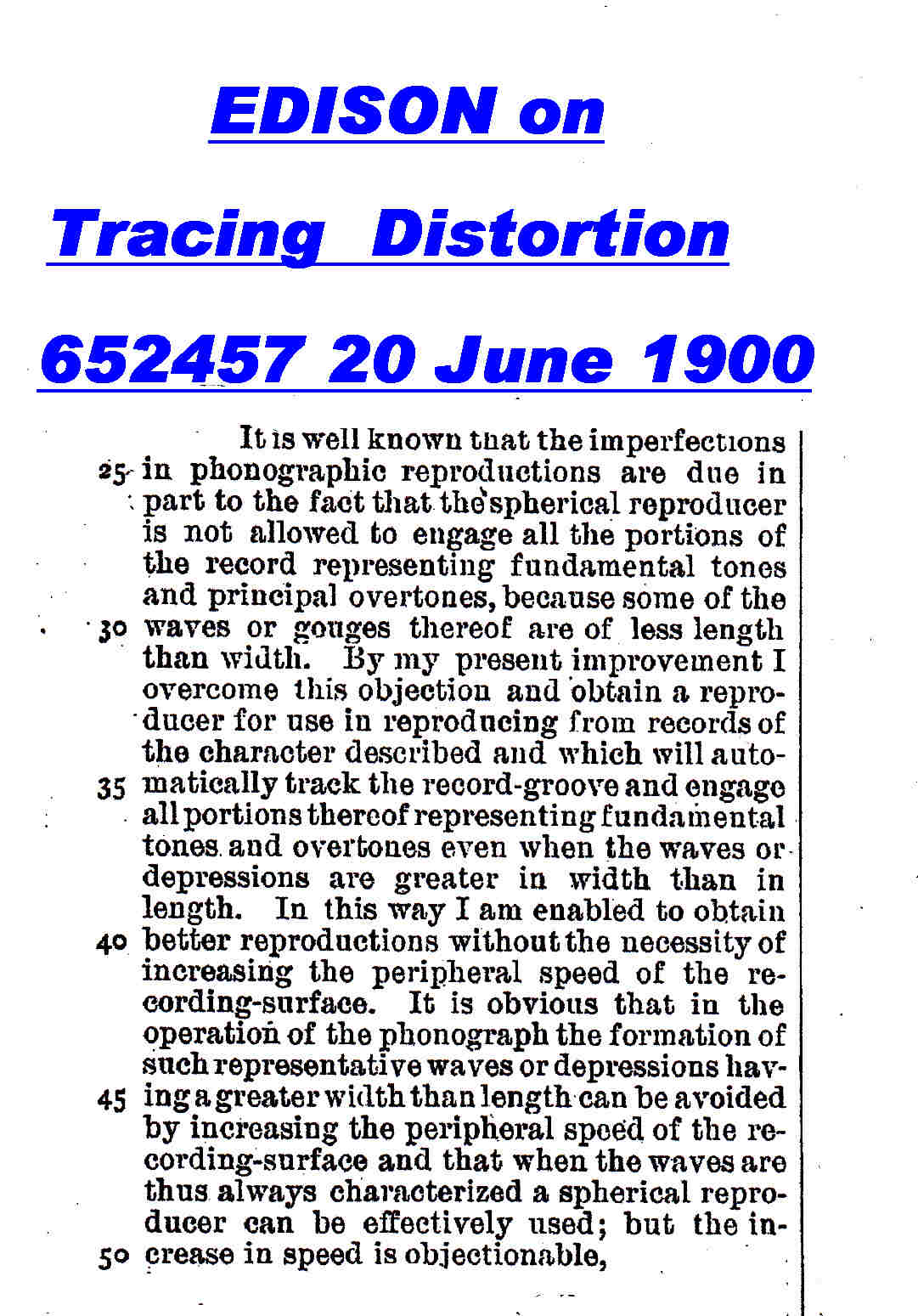 It is remarkable that Edison had considered the problem of tracing distortion
before 1900, and even more remarkable that he had invented and patented
a solution - the cylindrical stylus by 1899.
It is remarkable that Edison had considered the problem of tracing distortion
before 1900, and even more remarkable that he had invented and patented
a solution - the cylindrical stylus by 1899.
If a sphere traces a sinusoidal curve , the boundary condition is that the two
surfaces be tangental. The result is that the locus of the centre of the sphere is NOT
sinusoidal. This is called tracing distortion.
For very short recorded wavelengths there will come a time when the sphere
will no longer fit the hill and dale waveform at all.
An extract from the Edison patent describing this is shown opposite.
The language is formal and stilted but, nevertheless, the meaning is clear.
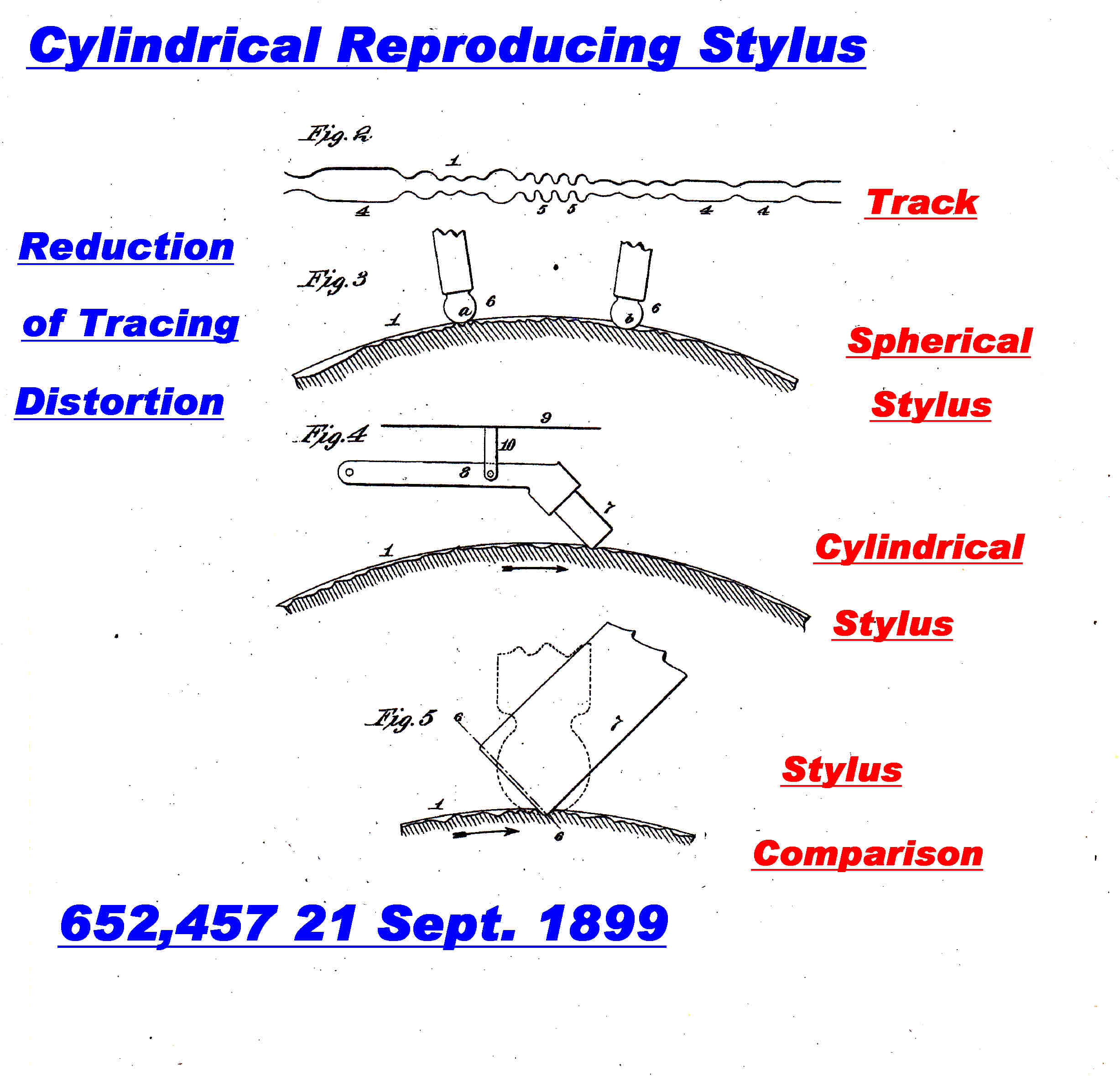 The aim in designing a reproducing stylus for vertical recording is to reduce the radius
of curvature along the groove while maximising the contact area.
The aim in designing a reproducing stylus for vertical recording is to reduce the radius
of curvature along the groove while maximising the contact area.
Tracing distortion can be reduced by decreasing the width of stylus contact
in the groove direction.
This reduces the contact area and increases the stylus pressure.
To recover more area the stylus must be extended across the groove.
In lateral recording the result is the elliptical stylus.
Long before the elliptical stylus, in fact by 1899, Edison had the solution for
vertical cut discs - the cylindrical reproducing stylus.
The appropriate patent is shown opposite.
If the edge of a cylinder is used as a stylus the above conditions are fulfilled.
Fig.2 is the plan of a track cut with an Edison circular cutter.
Fig.3 is a side view of a hill and dale track scanned with a spherical stylus.
Fig.4 is the same view, but with a cylindrical stylus.
Fig.5 is a ( somewhat exaggerated ) comparison of a cylindrical and spherical stylus.
With modern light weight high compliance pickups, the stylus diameter can be decreased
to a point where tracing distortion disappears. This is a valuable property of
vertical recording.
I use a 1 thou. spherical stylus at a weight of 1.5 grams. Unlike all my lateral 78s,
no tracing distortion is evident on the end of the Edison tracks.
The shape of the reproduced waveform when the spherical stylus is travelling over
a "hill" is different from when it traversing the bottom of a "dale".
The tracing distortion from a vertical cut disc shows asymmetry.
On the other hand, left and right deviations in a lateral track produce the
same distortion. The tracing distortion in lateral recording is therefore symmetrical.
The classical paper on tracing distortion is:-
A Theory of Tracing Distortion in Sound Reproduction from Phonograph Records
by W.D. Lewis and F.V. Hunt
The Journal of The Acoustical Society of America pp 348 - 365 1941
Now asymmetry produces even order distortion and symmetry produces odd order
distortion.
It is not surprising, then, that second order harmonic distortion in vertical recording
came out of the above analysis. The first distortion component in lateral recording
was third harmonic. This seemed to give vertical recording a bad name and interest was lost.
This is a pity.
Vertical recording has a lot of desirable characteristics such as: longer playing time:
freedom from retracking on overcutting: no problems with stylus fit.
All the acoustically recorded Edison discs were played back with a constant velocity
transfer function.
This is equivalent to play back on a perfect acoustic reproducer.
It is noted in the previous section on acoustic recording that Edison acoustic recorders approximated
the ideal constant velocity curve, but there were errors.
It would appear that the small recording horns were used as a high pass filter to reject low frequencies
where they would occupy valuable space on the track, but contribute nothing to the "loudness" :
the small reproducing horns would not respond to the low frequencies.
The output impedance of a conical horn goes highly reactive around the cutoff frequency and produces
a slow rolloff of low and intermediate frequencies rather than a sharp cutoff.
This can be seen in the computer simulation of the recorder steady state response in the last section.
This low frequency "droop" can be roughly approximated and equalised giving a sound with more "body".
Equalisation is only successful in the absence of noise, so discs with a good surface offer the most improvement.
For convenience the steady state results of the computer simulation are repeated here.

|

|
|
The response to a sinusoidal pressure wave of varying frequency at
the mouth of the horn is shown. |
The response to a sinusoidal pressure wave of varying frequency at
the mouth of the horn is shown. |
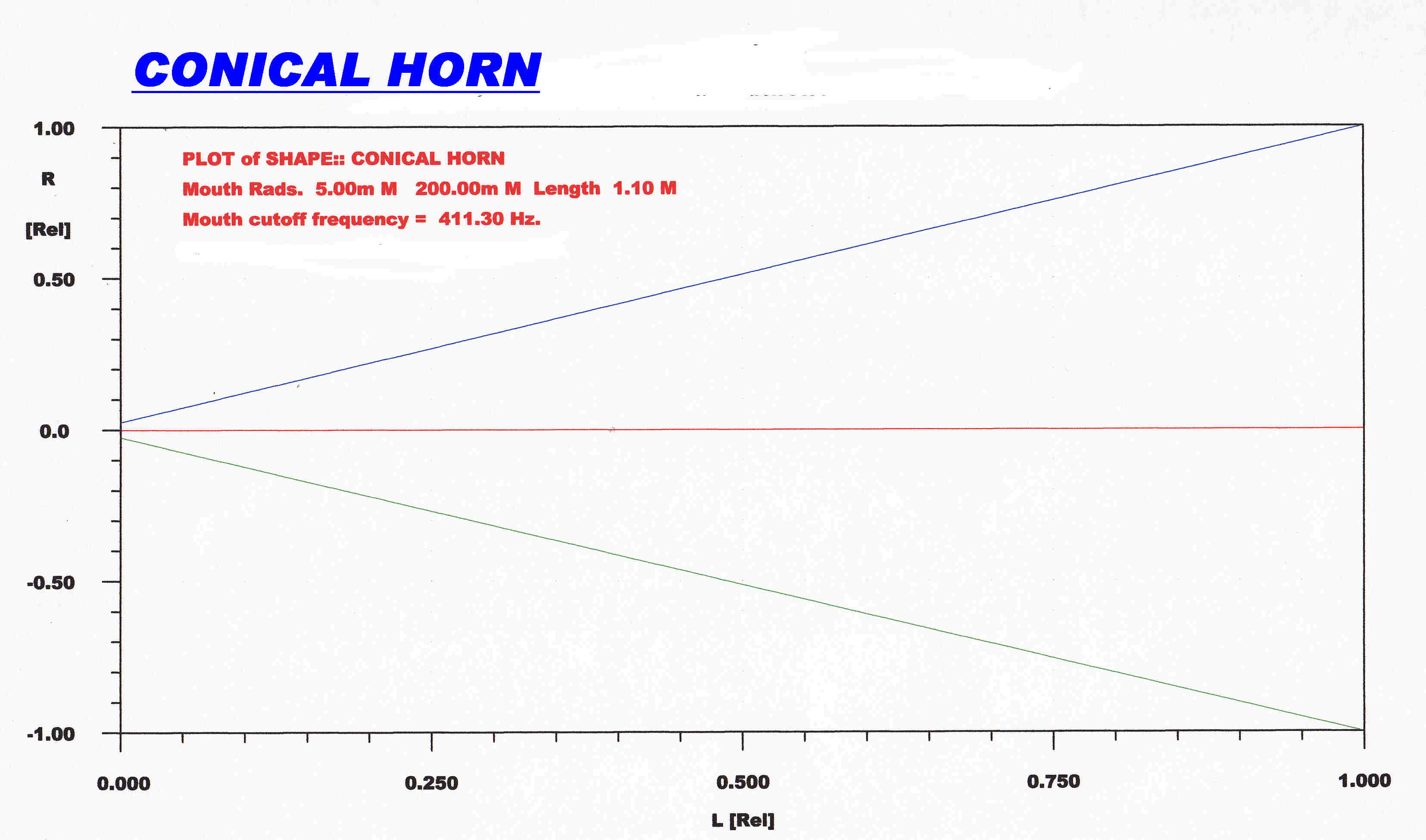
|
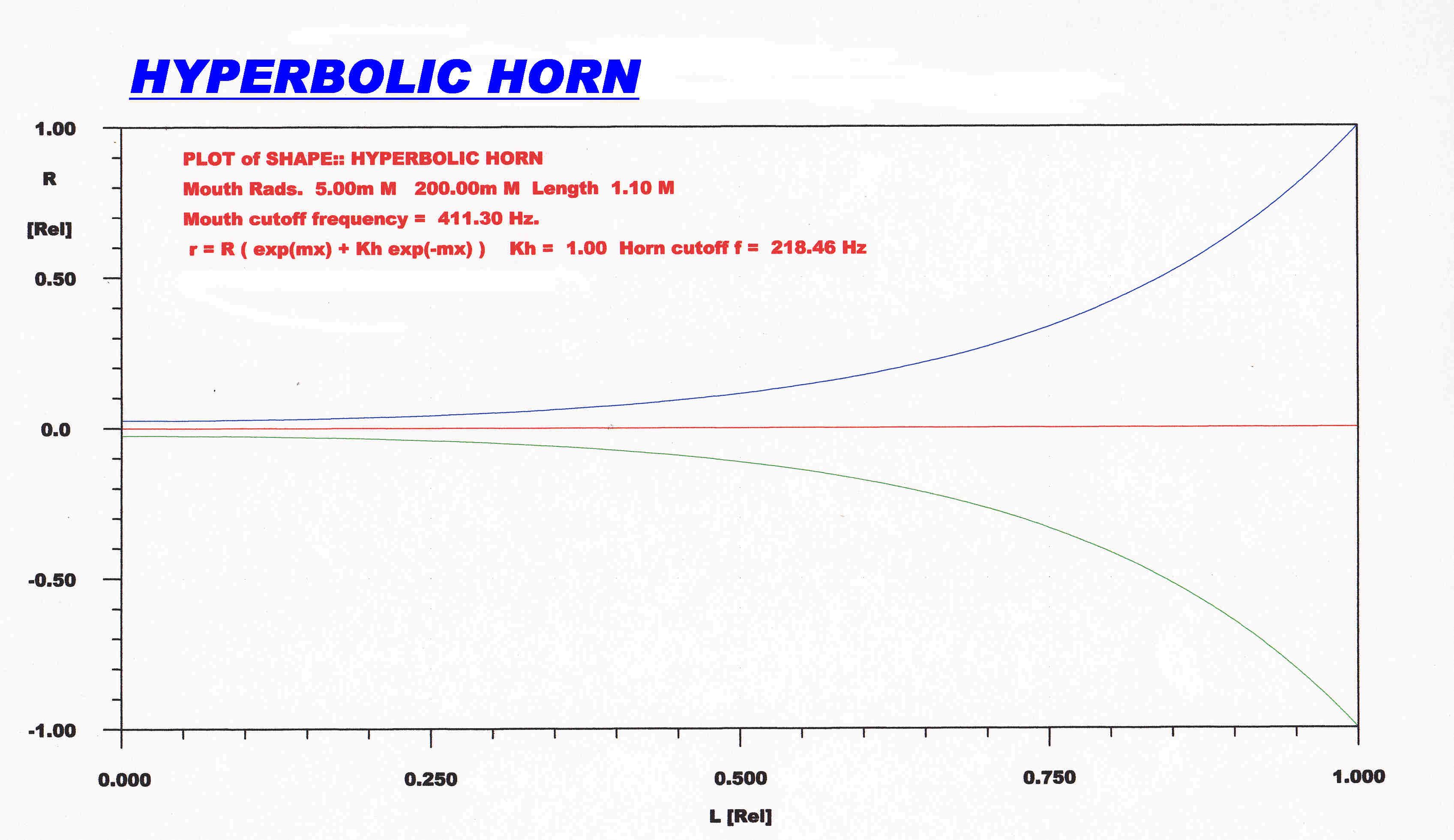
|
|
The shape of th conical horn used in the simulation is shown. |
The shape of th hyperbolic horn used in the simulation is shown. |
PLAY BACK DETAILS
ACOUSTICS
Playback characteristic:
Constant velocity.
Signal Filtering:-
4th Order Maximally Flat Low Pass 6.5KHz.
4th Order maximally Flat High Pass 100Hz.
Stylus Diameter: 1 thou. Spherical.
Tracking Weight: 1.5 grams.
ELECTRICALS
Playback characteristic:
Constant velocity above 250Hz.
Constant Amplitude below 250Hz.
Signal Filtering:-
4th Order Maximally Flat Low Pass 8KHz.
4th Order maximally Flat High Pass 50Hz.
Stylus Diameter: 1 thou. Spherical.
Tracking Weight: 1.5 grams.
Electrically Recorded Discs are denoted by an Asterisk on their Matrix Number: 18000*
Note: The average depth of cut on an Edison acoustic disc seems to be about 0.8 thou.,
so the maximum displacement with modulation is +(-) 0.8 thou..
The maximum displacement on a 78 lateral is about +(-) 2 thou., so the output from
an Edison diamond disc is about 10 db down on a lateral.
An Edison acoustic reproducer is much easier on a disc than the lateral equivalent,
which also had the nasty habit of sheddig slivers of steel onto the track.
Nevertheless Edison discs did wear, and all the discs featured show signs of wear.
Some of the distortion on heavily cut transients is due to wear - not the recording
or reproducing equipment.
TWO VERSIONS OF THE CONCERTS ARE PRESENTED
[1] CONSTANT VELOCITY AS REPRODUCED ON AN IDEAL ACOUSTIC REPRODUCER
[2] EQUALISED TRACKS TO CORRECT DYNAMIC ERRORS IN THE ACOUSTIC RECORDER
Note: The computer analysis shows that these low frequency dynamic errors are greatly reduced with the
use of a hyperbolic recording horn. Unfortunately this was developed after acoustic recording had ended.
PLAY WITH CONSTANT VELOCITY
PLAY EQUALISED VERSION
DISC DETAILS
PLAY WITH CONSTANT VELOCITY
PLAY EQUALISED VERSION
DISC DETAILS
PLAY WITH CONSTANT VELOCITY
PLAY EQUALISED VERSION
DISC DETAILS
PLAY WITH CONSTANT VELOCITY
PLAY EQUALISED VERSION
DISC DETAILS
PLAY WITH CONSTANT VELOCITY
PLAY EQUALISED VERSION
DISC DETAILS
PLAY WITH CONSTANT VELOCITY
PLAY EQUALISED VERSION
DISC DETAILS
PLAY WITH CONSTANT VELOCITY
PLAY EQUALISED VERSION
DISC DETAILS
PLAY WITH CONSTANT VELOCITY
PLAY EQUALISED VERSION
DISC DETAILS
PLAY WITH CONSTANT VELOCITY
PLAY EQUALISED VERSION
DISC DETAILS
Note: All the discs in Concert No 1 are acoustically recorded.
|
TRACK |
MATRIX |
CATALOG |
YEAR |
TITLE - ARTIST |
|
[1] |
11,372 |
51900-R |
1927 |
Where Do You Work-a John? - Earl Oliver's Jazz Babies |
|
[2] |
11,373 |
51900-L |
1927 |
Pretty Lips - Earl Oliver's Jazz Babies |
|
TRACK |
MATRIX |
CATALOG |
YEAR |
TITLE - ARTIST |
|
[3] |
10937 |
51745-R |
1926-1927 |
Chick, Chick, Chick, Chicken. - Earl Oliver's Jazz Babies. |
|
[4] |
10938 |
51745-L |
1926-1927 |
Show That Fellow The Door - Earl Oliver's Jazz Babies. |
|
TRACK |
MATRIX |
CATALOG |
YEAR |
TITLE - ARTIST |
|
[5] |
9772 |
51418-L |
1924-1925 |
Tea for Two - Green Brothers' Novelty Band |
|
[6] |
9770 |
51418-R |
1924-1925 |
Somebody Loves Me - Nathan Glantz and His Orchestra |
|
TRACK |
MATRIX |
CATALOG |
YEAR |
TITLE - ARTIST |
|
[7] |
10759 |
51679-L |
1926-1927 |
Love Bound - Jack Stillman's Orchestra |
|
[8] |
10758 |
51679-R |
1926-1927 |
Dreaming of a Castle in The Air - Jack Stillman's Orchestra. |
|
TRACK |
MATRIX |
CATALOG |
YEAR |
TITLE - ARTIST |
|
[9] |
11178 |
51826-L |
1926-1927 |
Measley Blues - Joe Candullo and His Everglades Orchestra |
|
[10] |
11177 |
51826-R |
1926-1927 |
Bass Ale Blues - Joe Candullo and His Everglades Orchestra. |
|
TRACK |
MATRIX |
CATALOG |
YEAR |
TITLE - ARTIST |
|
[11] |
10293 |
51538-L |
1925-1926 |
On The Oregon Trail - Golden Gate Orchestra |
|
[12] |
10290 |
51538-R |
1925-1926 |
Little Peach - Jack Stillman's Orchestra |
|
TRACK |
MATRIX |
CATALOG |
YEAR |
TITLE - ARTIST |
|
[13] |
8929 |
51155-L |
1923-1924 |
King Tut - Billy Jones and Ernest Hare |
|
[14] |
8923 |
51155-R |
1923-1924 |
Barney Google - Billy Jones and Ernest Hare |
|
TRACK |
MATRIX |
CATALOG |
YEAR |
TITLE - ARTIST |
|
[15] |
10565 |
51568-L |
1925-1926 |
The Old Grey Mare - Billy Jones and Ernest Hare |
|
[16] |
10505 |
51618-R |
1925-1926 |
How's Your Folks and My Folks - Billy Jones and Ernest Hare |
|
TRACK |
MATRIX |
CATALOG |
YEAR |
TITLE - ARTIST |
|
[17] |
7075 |
50661-L |
1920 |
Alice Blue Gown - Helen Clark |
|
[18] |
7077 |
50661-R |
1920 |
Irene - Helen Clark |
|
TRACK |
MATRIX |
CATALOG |
YEAR |
TITLE - ARTIST |
|
[19] |
8618 |
51089-R |
1922-1923 |
Lonesome Mama Blues - Fred Van Eps |
|
[20] |
8635 |
51089-L |
1922-1923 |
Frolic of The Coons - Fred Van Eps |
Note: The electrically recorded discs in CONCERT 2 are denoted by "*"
|
TRACK |
MATRIX |
CATALOG |
YEAR |
TITLE - ARTIST |
|
[1] |
18,314* |
52258-L |
1928-1929 |
That Wonderful Night and You |
|
[2] |
18313* |
52258-R |
1928-1929 |
Little Mother |
|
TRACK |
MATRIX |
CATALOG |
YEAR |
TITLE - ARTIST |
|
[3] |
18165* |
52229-R |
1928-1929 |
Old Plantation Melody |
|
[4] |
81166* |
55229-L |
1928-1929 |
A Memory that Time Cannot Erase |
|
TRACK |
MATRIX |
CATALOG |
YEAR |
TITLE - ARTIST |
|
[5] |
11235 |
51852-R |
1926-1927 |
Brown Sugar |
|
[6] |
11243 |
51852-L |
1926-1927 |
I Found a Million Dollar Baby in a Five and Ten Cents Store |
|
TRACK |
MATRIX |
CATALOG |
YEAR |
TITLE - ARTIST |
|
[7] |
9581 |
51362-R |
1924-1925 |
You'll Never Get To Heaven with Those Eyes |
|
[8] |
9575 |
51362-L |
1924-1925 |
I'll Keep on Dreaming |
|
TRACK |
MATRIX |
CATALOG |
YEAR |
TITLE - ARTIST |
|
[9] |
11762 |
52057-L |
1927 |
Rosa Lee |
|
[10] |
11760 |
52057-R |
1927 |
Gonna Get a Girl |
|
TRACK |
MATRIX |
CATALOG |
YEAR |
TITLE - ARTIST |
|
[11] |
9880 |
51455-R |
1924-1925 |
Nightingale |
|
[12] |
9777 |
51455-L |
1924-1925 |
Me and the Boyfriend |
|
TRACK |
MATRIX |
CATALOG |
YEAR |
TITLE - ARTIST |
|
[13] |
9619 |
51379-R |
1924-1925 |
Lonely Little Melody |
|
[14] |
9620 |
51379-L |
1924-1925 |
My Dream Girl |
|
TRACK |
MATRIX |
CATALOG |
YEAR |
TITLE - ARTIST |
|
[15] |
18460* |
52305-R |
1928-1929 |
Girl of My Dreams |
|
[16] |
18469* |
52305-L |
1928-1929 |
No Label |
|
TRACK |
MATRIX |
CATALOG |
YEAR |
TITLE - ARTIST |
|
[17] |
9698 |
51404-L |
1924-1925 |
Someone Loves You After All |
|
[18] |
9697 |
51404-R |
1924-1925 |
Along the Old Lake Trail |
|
TRACK |
MATRIX |
CATALOG |
YEAR |
TITLE - ARTIST |
|
[19] |
10938 |
51745-L |
1926-1927 |
Show That Fellow The Door |
|
[20] |
---- |
---- |
---- |
---- |
Note: The electrically recorded discs in CONCERT 3 are denoted by "*"
|
TRACK |
MATRIX |
CATALOG |
YEAR |
TITLE - ARTIST |
|
[1] |
11559 |
51972-R |
1927 |
There's A Little White House |
|
[2] |
11555 |
51972-L |
1927 |
You're The One for Me |
|
TRACK |
MATRIX |
CATALOG |
YEAR |
TITLE - ARTIST |
|
[3] |
9718 |
51407-L |
1924-1925 |
Words of Love |
|
[4] |
9670 |
61407-R |
1924-1925 |
Haunting Melody |
|
TRACK |
MATRIX |
CATALOG |
YEAR |
TITLE - ARTIST |
|
[5] |
18078* |
52159-L |
1928-1929 |
What'll You Do? |
|
[6] |
18077* |
52159-R |
1926-1927 |
There Must be Somebody Else |
|
TRACK |
MATRIX |
CATALOG |
YEAR |
TITLE - ARTIST |
|
[7] |
11769 |
52068-L |
1927 |
Danube Waves Waltz |
|
[8] |
11768 |
52068-R |
1927 |
Spring Beautiful Spring |
|
TRACK |
MATRIX |
CATALOG |
YEAR |
TITLE - ARTIST |
|
[9] |
10457 |
51581-R |
1925-1926 |
Funny |
|
TRACK |
MATRIX |
CATALOG |
YEAR |
TITLE - ARTIST |
|
[10] |
11299 |
51717-L |
1926-1927 |
Where Do You Work-A, John? |
|
[11] |
11276 |
51917-R |
1926-1927 |
Give Me a Ukulele (and a Ukulele Baby) and Leave The Rest to Me |
|
TRACK |
MATRIX |
CATALOG |
YEAR |
TITLE - ARTIST |
|
[12] |
9547 |
51355-L |
1924-1925 |
Love is Just a Gamble |
|
[13] |
9538 |
51355-R |
1924-1925 |
Driftwood |
|
TRACK |
MATRIX |
CATALOG |
YEAR |
TITLE - ARTIST |
|
[14] |
10458 |
51581-L |
1925-1926 |
Day Dreaming |
|
TRACK |
MATRIX |
CATALOG |
YEAR |
TITLE - ARTIST |
|
[15] |
10333 |
51552-R |
1925-1926 |
Who Takes Care of The Caretaker's Daughter |
|
[16] |
10291 |
51552-L |
1925-1926 |
We're Gonna Have Weather |
|
TRACK |
MATRIX |
CATALOG |
YEAR |
TITLE - ARTIST |
|
[17] |
51873-R |
51745-L |
1925-1926 |
Son of the Shiek |
Note: All the discs in Concert No 4 are acoustically recorded.
|
TRACK |
MATRIX |
CATALOG |
YEAR |
TITLE - ARTIST |
|
[1] |
10254 |
51527-L |
1924-1926 |
Chromatic |
|
[2] |
10253 |
551527-R |
1925-1926 |
No Label |
|
TRACK |
MATRIX |
CATALOG |
YEAR |
TITLE - ARTIST |
|
[3] |
11260 |
51863-L |
1926-1927 |
My Pal Jerry |
|
TRACK |
MATRIX |
CATALOG |
YEAR |
TITLE - ARTIST |
|
[4] |
9501 |
51343-R |
1924-1925 |
Spain |
|
[5] |
9506 |
51343-L |
1924-1925 |
Don't Blame It All On Me |
|
TRACK |
MATRIX |
CATALOG |
YEAR |
TITLE - ARTIST |
|
[6] |
8560 |
51031-R |
1922-1923 |
Cow Bells |
|
[7] |
8559 |
51031-L |
1922-1923 |
My Southern Home |
|
TRACK |
MATRIX |
CATALOG |
YEAR |
TITLE - ARTIST |
|
[8] |
8635 |
51089-L |
1922-1923 |
Frolic of The Coons |
|
[9] |
8618 |
51089-R |
1922-1923 |
Lonesome Mama Blues |
|
TRACK |
MATRIX |
CATALOG |
YEAR |
TITLE - ARTIST |
|
[10] |
10917 |
51730-R |
1926-1927 |
Rhythm of The Day |
|
[11] |
10918 |
51730-L |
1926-1927 |
Everybody's Charleston Crazy |
|
TRACK |
MATRIX |
CATALOG |
YEAR |
TITLE - ARTIST |
|
[12] |
9602 |
51374-R |
1919-1920 |
The Side Walks of New York |
|
[13] |
3586 |
51374-L |
1915-1916 |
I'm Just a Ragged Newsboy But my Heart is True Blue |
|
TRACK |
MATRIX |
CATALOG |
YEAR |
TITLE - ARTIST |
|
[14] |
10815 |
51686-R |
1926-1927 |
Always (part only) |
|
[15] |
10834 |
551686-L |
1926-1927 |
My Little Nest of Heavenly Blue (part only) |
|
TRACK |
MATRIX |
CATALOG |
YEAR |
TITLE - ARTIST |
|
[16] |
11513 |
51982-R |
1927 |
I'm Looking for a Girl Called Mary |
|
[17] |
11456 |
51892-L |
1927 |
That's What I Call a Pal |
|
TRACK |
MATRIX |
CATALOG |
YEAR |
TITLE - ARTIST |
|
[18] |
11004 |
51765-R |
1926-1927 |
Truly I Do |
Note: All the discs in Concert No 5 were acoustically recorded.
The surfaces of many of the discs used in this concert were so bad that it
was difficult to recover a useable signal.
|
TRACK |
MATRIX |
CATALOG |
YEAR |
TITLE - ARTIST |
|
[1] |
9501 |
51343-R |
1924-1925 |
Spain |
|
[2] |
9506 |
51343-L |
1924-1925 |
Don't Blame It All on Me |
|
TRACK |
MATRIX |
CATALOG |
YEAR |
TITLE - ARTIST |
|
[3] |
9028 |
82297-R |
1923-1924 |
Long Ago in Alcalar |
|
[4] |
9029 |
82297-L |
1923-1924 |
Down Deep Within the Cellar |
|
TRACK |
MATRIX |
CATALOG |
YEAR |
TITLE - ARTIST |
|
[5] |
11260 |
51863-L |
1926-1927 |
My Pal Jerry |
|
[6] |
11004 |
51765-R |
1926-1927 |
Truly I Do |
|
TRACK |
MATRIX |
CATALOG |
YEAR |
TITLE - ARTIST |
|
[7] |
8560 |
51031-R |
1922-1923 |
Cow Bells |
|
[8] |
8559 |
51031-L |
1922-1923 |
My Southern Home |
|
TRACK |
MATRIX |
CATALOG |
YEAR |
TITLE - ARTIST |
|
[9] |
2490 |
Black Label |
1913-1914 |
Glow Worm |
|
[10] |
2630 |
Black Label |
1913-1914 |
Garden of Roses Waltz |
|
TRACK |
MATRIX |
CATALOG |
YEAR |
TITLE - ARTIST |
|
[11] |
4250 |
83063-L |
1915-1916 |
The Bandelero |
|
[12] |
4934 |
83063-R |
1916-1917 |
Stille Nacht ! Hellige Nacht ! |
|
TRACK |
MATRIX |
CATALOG |
YEAR |
TITLE - ARTIST |
|
[13] |
3764 |
80293-R |
1915-1916 |
Mother Machree |
|
[14] |
4168 |
80293-L |
1915-1916 |
My Wild Irish Rose |
|
TRACK |
MATRIX |
CATALOG |
YEAR |
TITLE - ARTIST |
|
[15] |
10254 |
51527-L |
1925-1926 |
Chromatic |
|
[16] |
10253 |
No Label |
1925-1926 |
No Label |
|
TRACK |
MATRIX |
CATALOG |
YEAR |
TITLE - ARTIST |
|
[17] |
11513 |
51982-R |
1927 |
I'm Looking for a Girl Called Mary |
|
[18] |
11456 |
51982-L |
1927 |
That's What I Call a Pal |
|
TRACK |
MATRIX |
CATALOG |
YEAR |
TITLE - ARTIST |
|
[19] |
10815 |
51686-R |
1922-1923 |
Always |
Note: All the discs in this concert are acoustically recorded
|
TRACK |
MATRIX |
CATALOG |
YEAR |
TITLE - ARTIST |
|
[1] |
10706 |
51677-R |
1926-1927 |
Hokey Pokey Diddle Dee-Dum |
|
[2] |
10756 |
51677-L |
1926-1927 |
I Wish I Was in Peoria |
|
TRACK |
MATRIX |
CATALOG |
YEAR |
TITLE - ARTIST |
|
[3] |
9907 |
51470-L |
1924-1925 |
Laff It Off |
|
[4] |
9885 |
51470-R |
1924-1925 |
On My Ukulele |
|
TRACK |
MATRIX |
CATALOG |
YEAR |
TITLE - ARTIST |
|
[5] |
10381 |
51577-L |
1925-1926 |
The King Isn't King Anymore |
|
[6] |
10426 |
51577-R |
1925-1926 |
The Farmer took Another Load Away Hay! Hay! |
|
TRACK |
MATRIX |
CATALOG |
YEAR |
TITLE - ARTIST |
|
[7] |
10201 |
51526-L |
1925-1926 |
I'll Make the Pies Like Your Mother Made |
|
[8] |
10236 |
51526-R |
1925-1926 |
I'm Looking for a Union Sweethart |
|
TRACK |
MATRIX |
CATALOG |
YEAR |
TITLE - ARTIST |
|
[9] |
9791 |
51430-L |
1924-1925 |
Ain't You Comin' Out Tonight? |
|
[10] |
9779 |
51430-R |
1924-1925 |
It Ain't Gonna Rain No Mo' |
|
TRACK |
MATRIX |
CATALOG |
YEAR |
TITLE - ARTIST |
|
[11] |
10962 |
51755-L |
1926-1927 |
The Lunatic's Lullaby |
|
[12] |
10961 |
51755-R |
1926-1927 |
The Pump song |
|
TRACK |
MATRIX |
CATALOG |
YEAR |
TITLE - ARTIST |
|
[13] |
11318 |
51884-R |
1926-1927 |
Schultz Is Back Again |
All the discs in this concert are acoustically rcorded
|
TRACK |
MATRIX |
CATALOG |
YEAR |
TITLE - ARTIST |
|
[1] |
11559 |
51972-R |
1927 |
There's a Little White House |
|
[2] |
11555 |
51972-L |
1927 |
You're the One for Me |
|
TRACK |
MATRIX |
CATALOG |
YEAR |
TITLE - ARTIST |
|
[3] |
9718 |
51407-L |
1924-1925 |
Words of Love |
|
[4] |
9670 |
51407-R |
1924-1925 |
Haunting Melody |
|
TRACK |
MATRIX |
CATALOG |
YEAR |
TITLE - ARTIST |
|
[5] |
10725 |
51666-R |
1926-1927 |
The Prisoner's Song |
|
[6] |
10726 |
51666-L |
1926-1927 |
I'll Take You Home again Kathleen |
|
TRACK |
MATRIX |
CATALOG |
YEAR |
TITLE - ARTIST |
|
[7] |
10333 |
51522-R |
1925-1926 |
Who Takes care of the Caretaker's Daughter |
|
[8] |
10291 |
51552-L |
1925-1926 |
We're Gonna Have Weather |
|
TRACK |
MATRIX |
CATALOG |
YEAR |
TITLE - ARTIST |
|
[9] |
9982 |
51565-L |
1924-1925 |
Old Lady |
|
[10] |
9981 |
51565-R |
1924-1925 |
Colnel Bogey March ( part only ) |
|
TRACK |
MATRIX |
CATALOG |
YEAR |
TITLE - ARTIST |
|
[11] |
8695 |
51111-R |
1922-1923 |
On a Moonlight Night |
|
[12] |
8696 |
51111-L |
1922-1923 |
Underneath the Mellow Moon |
|
TRACK |
MATRIX |
CATALOG |
YEAR |
TITLE - ARTIST |
|
[13] |
10850 |
51706-R |
1926-1927 |
Lo-Nah |
|
[14] |
10851 |
51706-L |
1926-1927 |
Tentin' Down in Tennessee |
|
TRACK |
MATRIX |
CATALOG |
YEAR |
TITLE - ARTIST |
|
[15] |
9563 |
51356-R |
1924-1925 |
Somewhere in Napoli |
|
[16] |
9564 |
51356-L |
1924-1925 |
In Dreams with You |
|
TRACK |
MATRIX |
CATALOG |
YEAR |
TITLE - ARTIST |
|
[17] |
11302 |
51887-R |
1926-1927 |
Because I Love You |
|
[18] |
11380 |
51906-R |
1927 |
Still Waters |
|
TRACK |
MATRIX |
CATALOG |
YEAR |
TITLE - ARTIST |
|
[1] |
9547 |
51355-L |
1924-1925 |
Love is Just a Gamble |
|
[2] |
9538 |
51355-R |
1924-1925 |
Driftwood |
|
TRACK |
MATRIX |
CATALOG |
YEAR |
TITLE - ARTIST |
|
[3] |
18744* |
52418-R |
1928-1929 |
Somewhere a Voice is Calling |
|
[4] |
18743* |
52418-L |
1928-1929 |
Mavis |
|
TRACK |
MATRIX |
CATALOG |
YEAR |
TITLE - ARTIST |
|
[5] |
10457 |
51581-R |
1925-1926 |
Funny |
|
[6] |
10458 |
51581-L |
1925-1926 |
Day Dreaming |
|
TRACK |
MATRIX |
CATALOG |
YEAR |
TITLE - ARTIST |
|
[7] |
18078* |
52159-L |
1928-1929 |
What'll You Do? |
|
[8] |
18077* |
52159-R |
1928-1929 |
There Muat be Somebody Else |
|
TRACK |
MATRIX |
CATALOG |
YEAR |
TITLE - ARTIST |
|
[9] |
9602 |
51374-R |
1919-1920 |
The Side Walks of New York |
|
[10] |
3586 |
51374-L |
1915-1916 |
I'm Just a Ragged Newsboy but My Heart's True Blue |
|
TRACK |
MATRIX |
CATALOG |
YEAR |
TITLE - ARTIST |
|
[11] |
11769 |
52068-L |
1927 |
Danube Waves Waltz |
|
[12] |
11768 |
52068-R |
1927 |
Spring, Beautiful Spring |
|
TRACK |
MATRIX |
CATALOG |
YEAR |
TITLE - ARTIST |
|
[13] |
11270 |
51873-R |
1925-1926 |
Son of the Shiek |
|
[14] |
5258 |
50410-L |
1917-1918 |
The New Colonial March |
|
TRACK |
MATRIX |
CATALOG |
YEAR |
TITLE - ARTIST |
|
[15] |
5259 |
50410-R |
1917-1918 |
American Eagle March |
|
[16] |
5273 |
50455-R |
1917-1918 |
One, Two, Three, Four |
|
TRACK |
MATRIX |
CATALOG |
YEAR |
TITLE - ARTIST |
|
[17] |
5107 |
50455-L |
1916-1917 |
Ellis March |
|
[18] |
6912 |
50671-R |
1919-1920 |
Semper Fidelis March |
|
TRACK |
MATRIX |
CATALOG |
YEAR |
TITLE - ARTIST |
|
[19] |
6114 |
50671-L |
1918-1919 |
Trumpeter's Carnival |
|
TRACK |
MATRIX |
CATALOG |
YEAR |
TITLE - ARTIST |
|
[1] |
10918 |
51732-L |
1926 |
Everybody's Charleston Crazy |
|
[2] |
10917 |
51730-R |
1926 |
Rhythm of The Day |
|
TRACK |
MATRIX |
CATALOG |
YEAR |
TITLE - ARTIST |
|
[3] |
10929 |
51737-L |
1926-1927 |
What a Man! |
|
[4] |
10930 |
51737-R |
1926-1927 |
Shake |
|
TRACK |
MATRIX |
CATALOG |
YEAR |
TITLE - ARTIST |
|
[5] |
11034 |
51786-R |
1926-1927 |
My Dream of The Big Parade |
|
[6] |
10948 |
51786-L |
1926-1927 |
Gone! |
|
TRACK |
MATRIX |
CATALOG |
YEAR |
TITLE - ARTIST |
|
[7] |
11083 |
51793-R |
1926-1927 |
Breezin' Along with The Breeze |
|
[8] |
11086 |
51793-L |
1926-1927 |
Who Wouldn't ? |
|
TRACK |
MATRIX |
CATALOG |
YEAR |
TITLE - ARTIST |
|
[9] |
3726 |
Black Label |
1915 |
The Stars and Stripes Forever |
|
[10] |
9187 |
80867-L |
1924 |
Danube Waves Waltz |
|
TRACK |
MATRIX |
CATALOG |
YEAR |
TITLE - ARTIST |
|
[11] |
8742 |
51208-R |
1923 |
Who's Sorry Now ? |
|
[12] |
9084 |
51208-L |
1923 |
Broken Hearted Melody |
|
TRACK |
MATRIX |
CATALOG |
YEAR |
TITLE - ARTIST |
|
[13] |
4122 |
50968-L |
1915 |
Dominion of Canada March |
|
[14] |
5761 |
50968-R |
1918 |
The Three Republics Grand March |
|
TRACK |
MATRIX |
CATALOG |
YEAR |
TITLE - ARTIST |
|
[15] |
10577 |
51624-R |
1925 |
Pardon Me Ha! Ha! Ha! While I Laugh |
|
[16] |
10583 |
51624-L |
1925 |
Old Uncle Bill |
|
TRACK |
MATRIX |
CATALOG |
YEAR |
TITLE - ARTIST |
|
[17] |
10268 |
51528-R |
1925-1926 |
By The Waters of Minnetonka |
|
[18] |
10269 |
51528-L |
1925-1926 |
In The Garden of Tomorrow |
|
TRACK |
MATRIX |
CATALOG |
YEAR |
TITLE - ARTIST |
|
[19] |
7118 |
50674-R |
1920 |
The Homeward march |
As discussed in the previous section, the (non-linear) distortion in the acoustic hill and dale
recording process is inherently low.
The disc cutting force presents a non-linear load to the cutting head, but this can be made small
compared with the viscous damping force: and so reduce distortion to a low value.
Nevertheless, non-linear distortion does occur on playback.
This is mostly due to wear and has a significant signiture: the distortion increases towards the
centre of the disc.
High frequency transients produce a sharp spike or hill on the track. The width ( and the structural
strength) of this decreases with velocity, and so more damage is done by the large dynamic forces of
the acoustic reproducer towards the centre of the disc.
In some discs the distortion is uniform across the surface, and it can be inferred that the distortion
occurred in the manufacturing process.
Tracks 17 and 18 in concert No. 9 are good examples of this.
They are repeated here for convenience.
PLAY DISTORTED TRACKS
The fact that the same type of distortion appears on both sides of the disc strongly points to
manufacturing faults.
Unlike their lateral counterparts, the stampers for hill and dale recording are fragile and highly
susceptible to damage and wear.
This presented an enormous manufacturing problem, and was frequently the source of distortion.
This is discussed in the next section.
High frequency transients appear as thin hair like spikes protruding from the surface of
hill and dale stampers.
Their structural strength is very low and they are very easily damaged - particularly if the stamper is laid
on a flat hard surface.
They are unable to support the weight of the stamper.
The damage is equivalent to clipping the peaks on the audio and the result is horrendous distortion.
Edison describes this in his patent 1417463 of 1919.
I quote:-
"These minute projections of the sound record matrices are subjected to considerable wear and are very
apt to be injured by the record blanks disposed between the dies."
The full patent is shown below:-

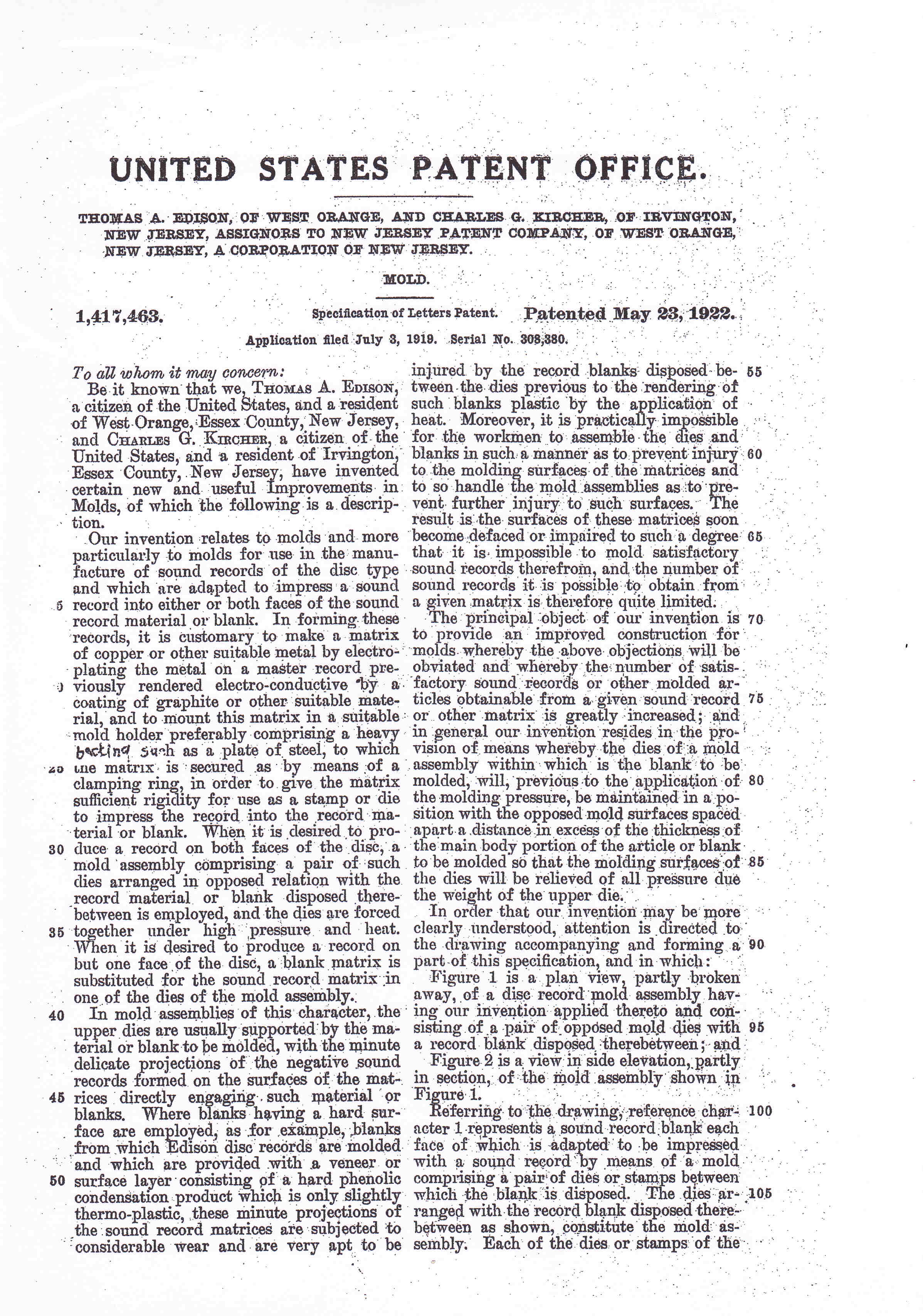

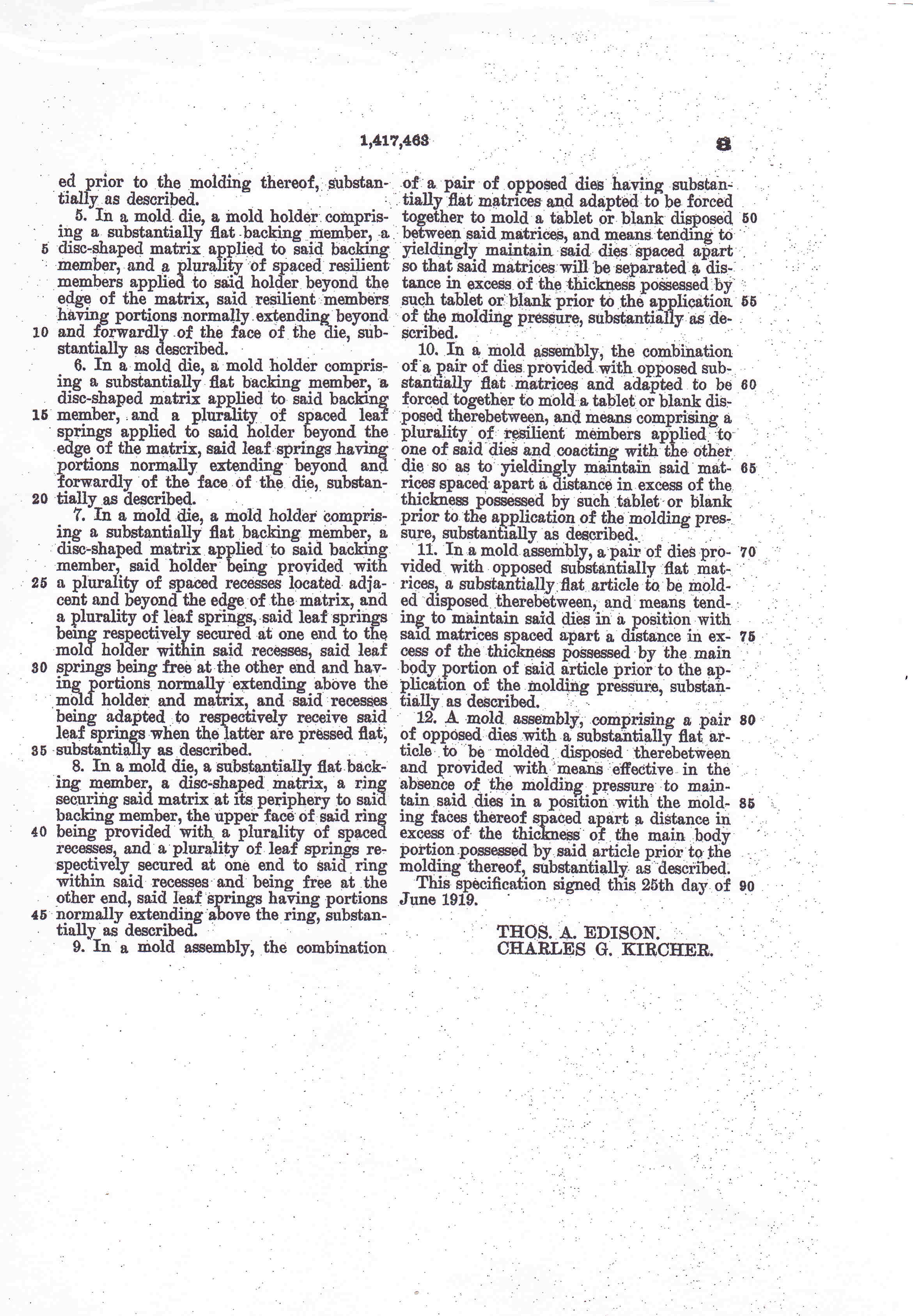
The composition and full directions for constructing the cores are given in
the following patents:-
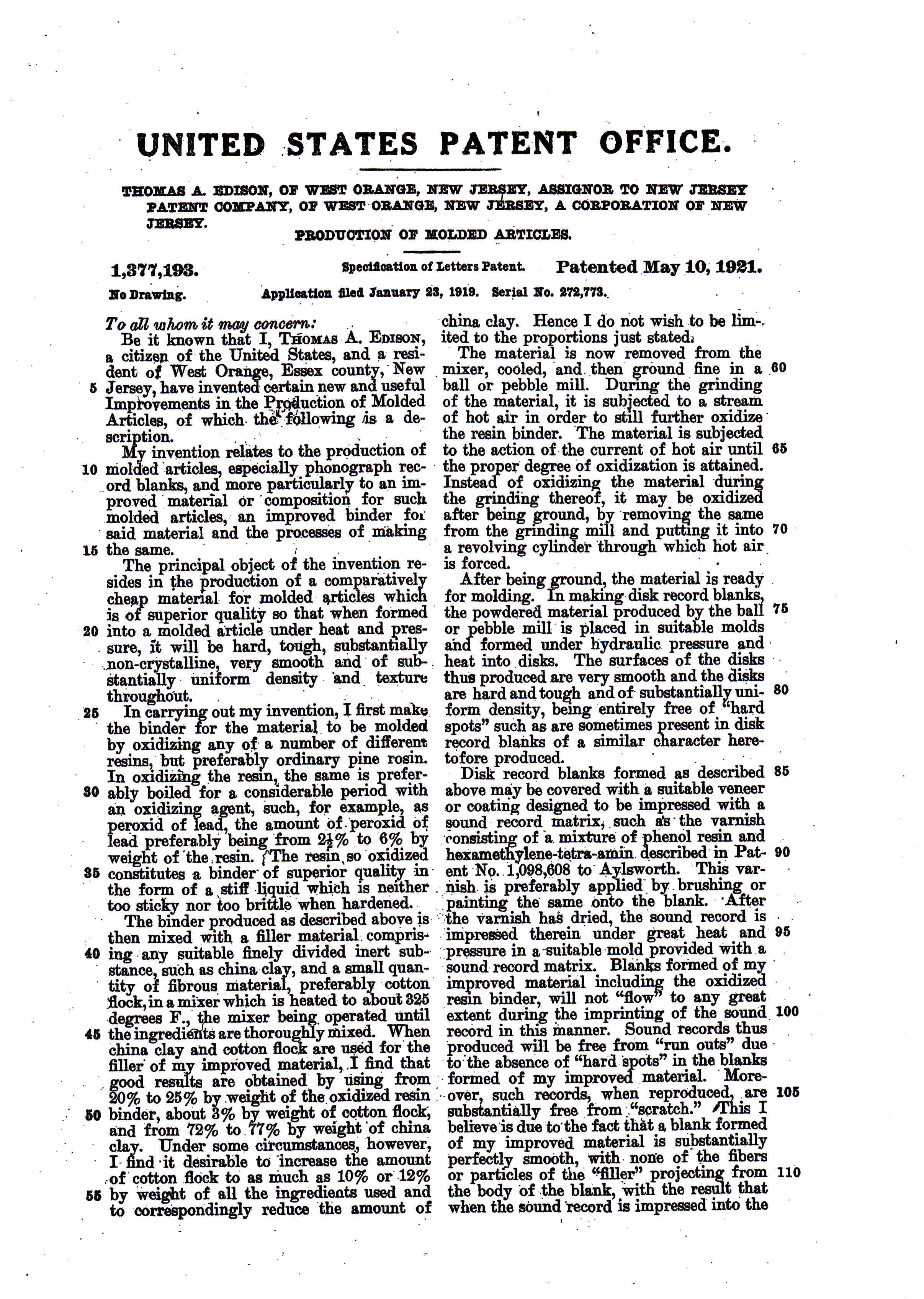


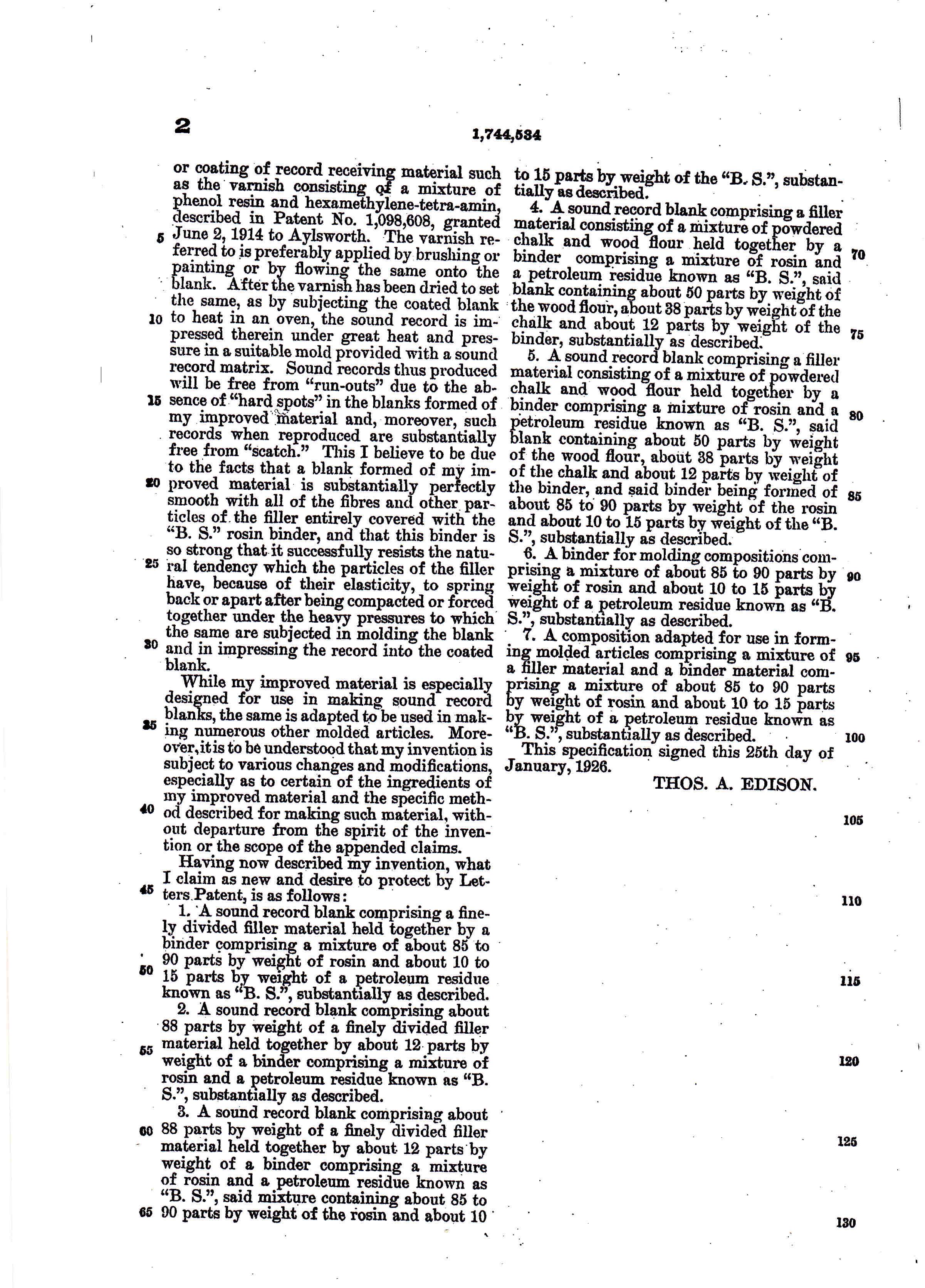
Frequently insufficient condensite was applied to the surface of the blank and the rough surface
penetrated into the track causing surface noise.
The process is described here:-
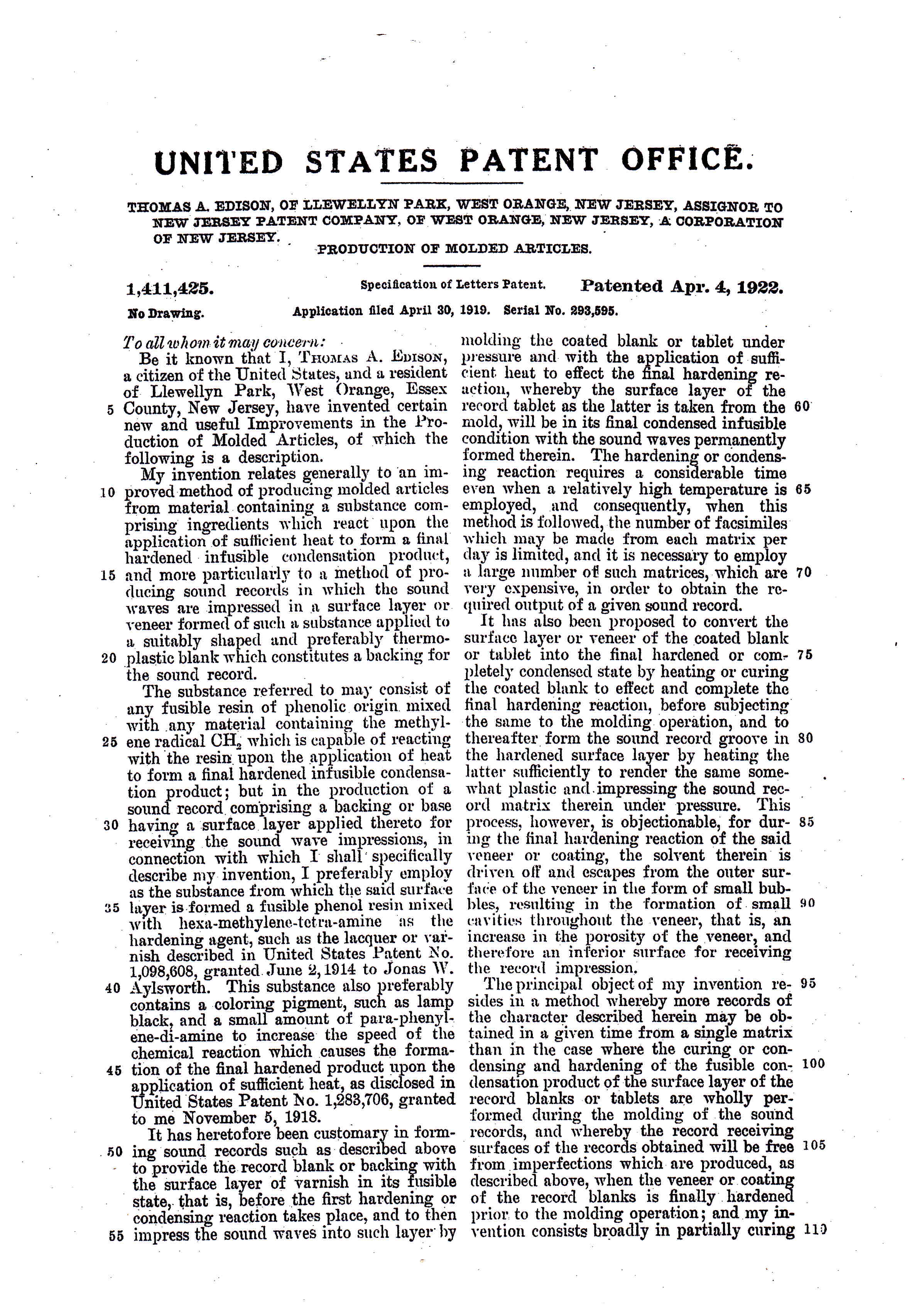
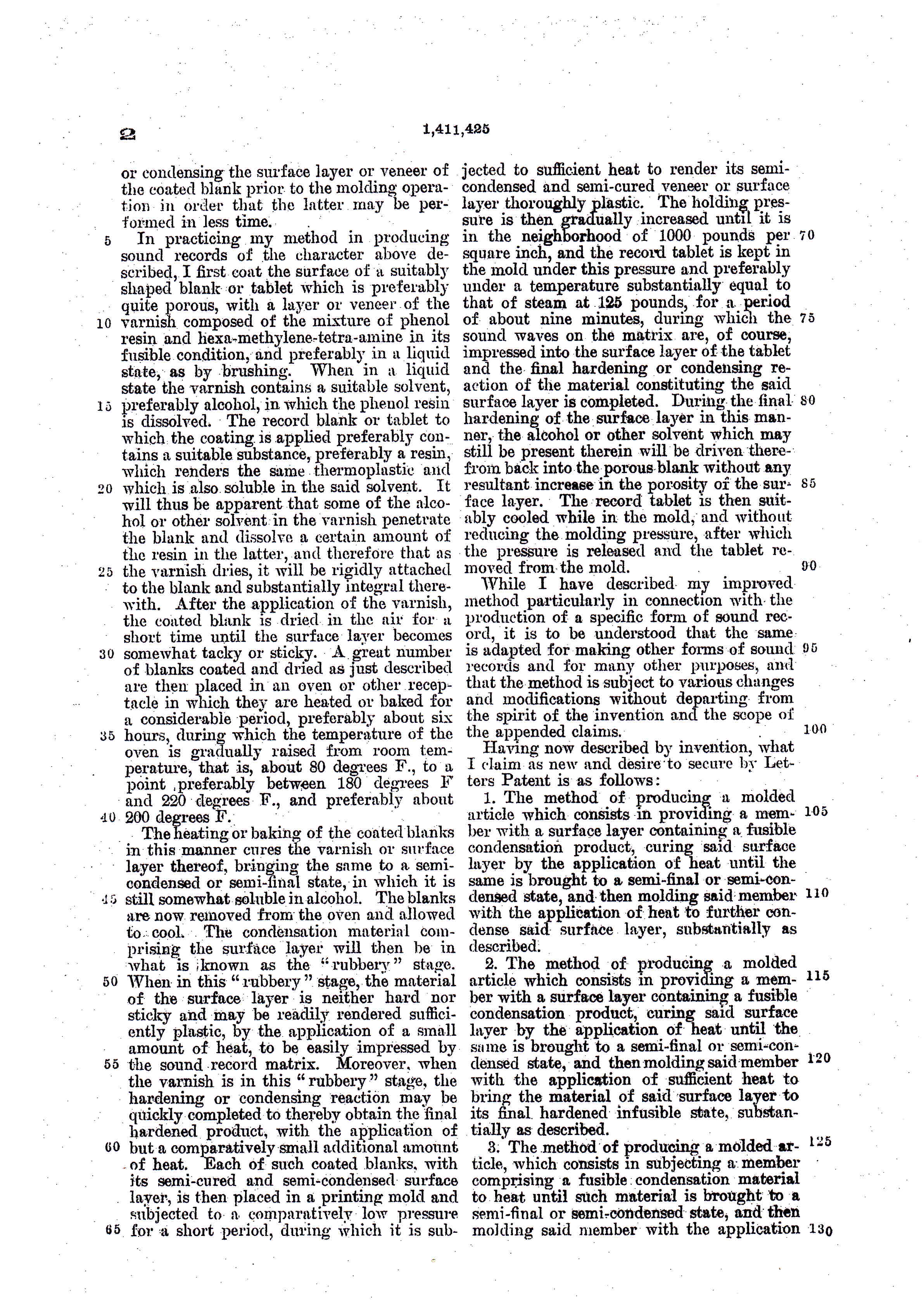

The surface layers of condensite sometimes shrink on the blank causing rough patches.
These cause "rumble" and low frequency surface noise.
This effect is particularly disastrous on electrically recorded discs since these require low frequency
boost for the equalisation of their recording characteristic.
The effect is evident in tracks 3 and 4 of Concert No. 2
This is discussed in the following patent:-
